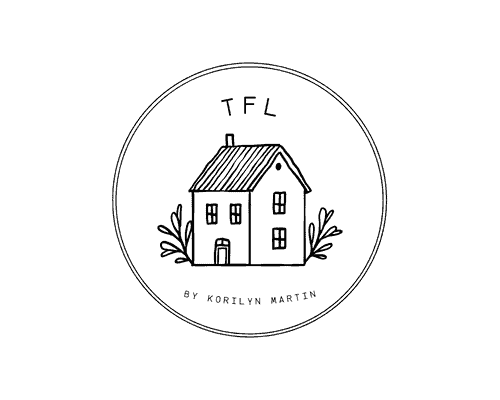Blinds vs Shades: What’s the Difference and When To Use Which
Blinds and shades are two popular options for window coverings, each offering unique features and benefits. Blinds, such as Venetian blinds or vertical blinds, consist of adjustable slats that allow precise control over light and privacy levels.
They come in a variety of materials and styles, offering a sleek and modern aesthetic. On the other hand, shades, like roller shades or cellular shades, are made from a continuous piece of fabric that can be raised or lowered to control light and privacy.
Window Shades provide a softer and more elegant look, with best options for light filtering or blackout capabilities. Understanding the differences between blinds and window shades can help you make an informed decision when choosing the right window treatment for your home.
Blinds vs. Shades: What’s the Difference?
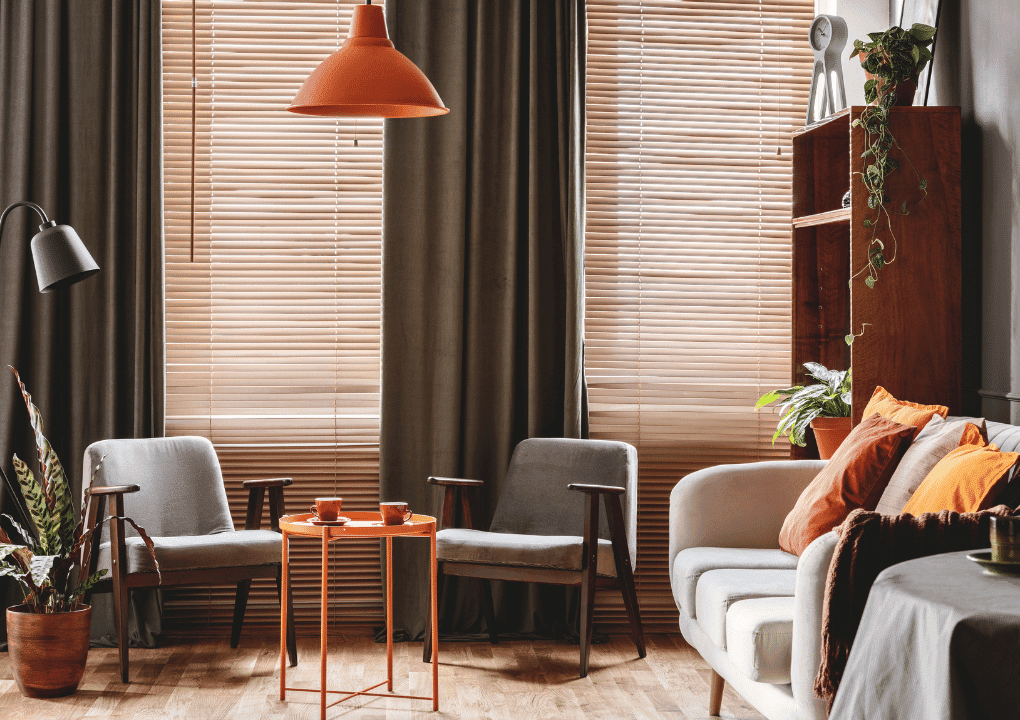
Design: Blinds are made up of individual slats or vanes that can be adjusted to control the amount of light and privacy. They are typically made of materials like wood, aluminum, vinyl or my favorite, faux wood. Shades, on the other hand, are made of a single piece of fabric or material that can be raised or lowered to adjust the light and privacy levels.
Light Control: Blinds offer more precise control over light and privacy because you can tilt or rotate the slats to allow in or block out light. With shades, you can typically only raise or lower them to adjust the amount of light entering the room.
Privacy: Blinds provide better privacy when the slats are closed, as they can be adjusted to prevent others from seeing inside while still allowing some light to filter through. Shades, when fully lowered, generally provide more privacy as they cover the entire large window with a single piece of material.
Style and Appearance: Blinds and shades come in various styles, colors, and patterns to suit different decor preferences. Blinds with their slatted design often provide a more contemporary or traditional look, while shades, with their smooth, continuous fabric appearance, can offer a softer and more streamlined aesthetic.
Cleaning and Maintenance: Blinds, especially those with individual slats, require more frequent cleaning and maintenance. Dust and dirt can accumulate on the slats, necessitating regular wiping or vacuuming. Shades are generally easier to clean as they consist of a single piece of fabric, so I generally just use my dust attachment on my vacuum.
Price: The cost of blinds and shades can vary depending on factors such as material, size, and brand. In general, blinds tend to be slightly more expensive than shades due to their construction and mechanism.
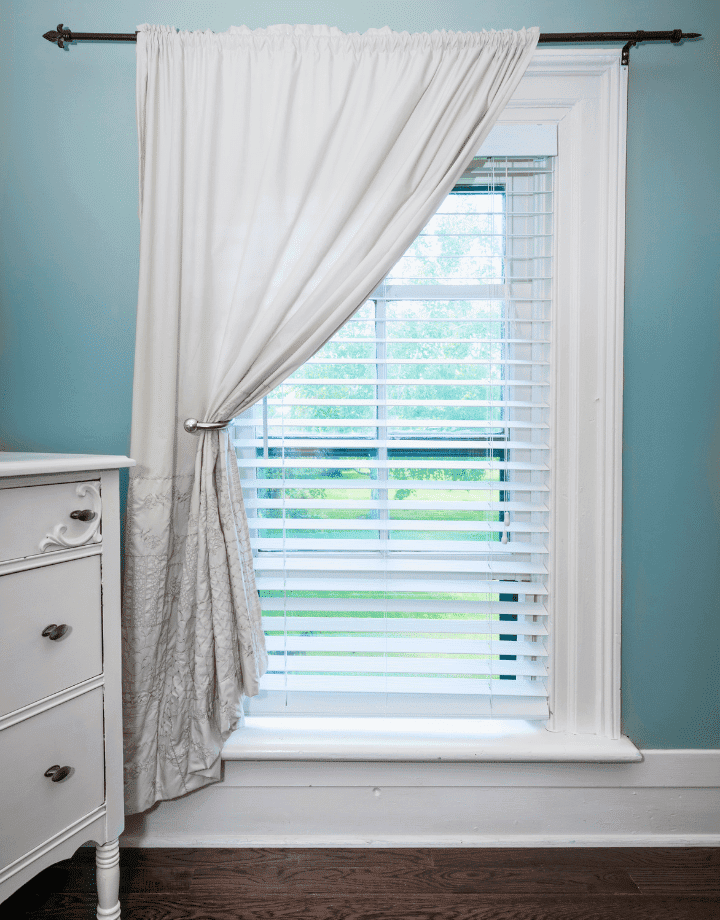
When are blinds best used?
Blinds are best used in several scenarios:
Light Control: Blinds offer precise control over the amount of light entering a room. You can adjust the slats to let in as much or as little light as desired, making them ideal for areas where you want to regulate natural light, such as bedrooms, living rooms, or home offices.
Privacy: Blinds provide an excellent level of privacy. By tilting the slats, you can block the view from the outside while still allowing light to filter in. I like to use them in rooms where privacy is essential, such as bathrooms or ground-level windows.
Modern Aesthetics: Blinds offer a sleek and contemporary look, making them a popular choice for modern and minimalist interior designs. They can complement clean lines and provide a sophisticated touch to any room.
Easy Maintenance: Blinds are relatively easy to clean and maintain. I like to wipe mine down with a damp cloth to keep them dusted regularly and looking fresh!
Versatility: Blinds come in various materials, including aluminum, wood, faux wood, or vinyl, offering a wide range of options to match different decor styles. They are available in different sizes, colors, and finishes, making it easier to find blinds that suit your specific preferences and requirements.
Is it OK to have different blinds in different rooms?
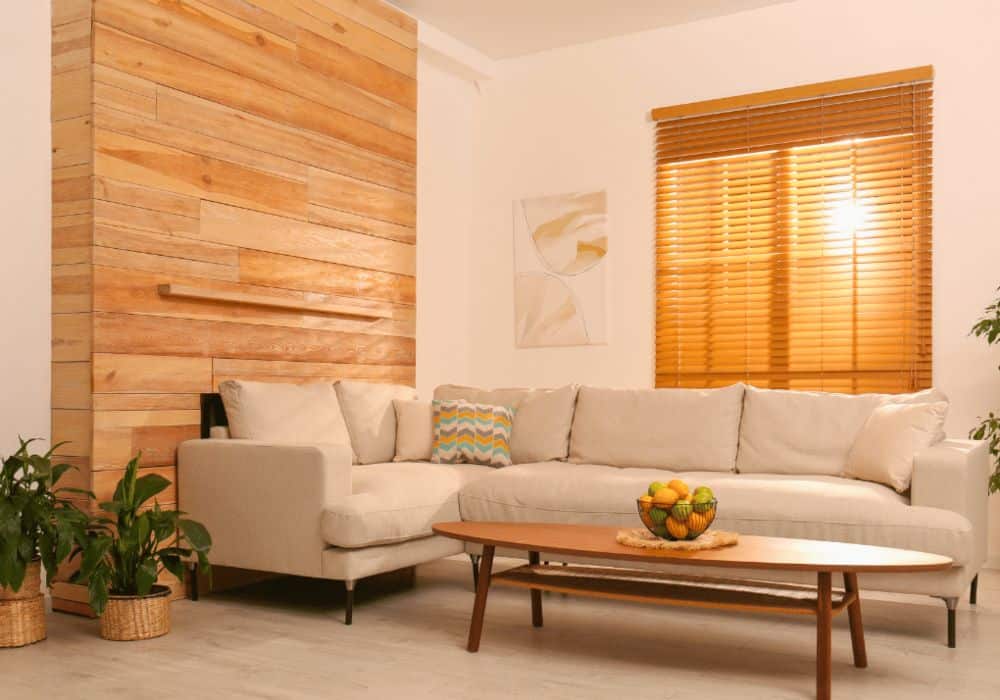
Yes, it is absolutely okay to have different blinds in different rooms. In fact, it can be a creative and practical approach to window treatments. Here are a few reasons why having different blinds in different rooms can be a good choice:
Room-Specific Needs:
Each room in your home has its own unique requirements and functions. For example, you may want more privacy in the bedroom, greater light control in the living room, or a softer ambiance in the dining area. Choosing different blinds allows you to address the specific needs of each room.
Aesthetics and Style:
Different rooms may have varying decor styles or color schemes. By selecting blinds that complement the specific design elements of each room, you can create a cohesive and visually appealing look. This approach adds depth and character to your home.
Personal Preference:
Each individual has their own preferences when it comes to window treatments. There are different types of window treatments. By allowing different blinds in different rooms, you can cater to personal tastes and create spaces that reflect the unique personalities of the occupants.
Window Sizes and Shapes:
Not all windows are the same size or shape. Some rooms may have large windows or small windows, while others may have bay windows or skylights. Choosing different blinds including horizontal blinds allows you to find the best fit for each window, ensuring proper coverage and functionality.
Flexibility in Budget and Materials:
Blinds come in a wide range of materials, from affordable options to higher-end choices. By selecting different blinds for different rooms, you can allocate your budget wisely and choose materials that best suit the specific requirements of each space.
Remember, the key is to strike a balance and maintain a cohesive overall aesthetic. Consider factors such as color coordination, material consistency, and the overall flow between rooms to ensure a harmonious look throughout your home.
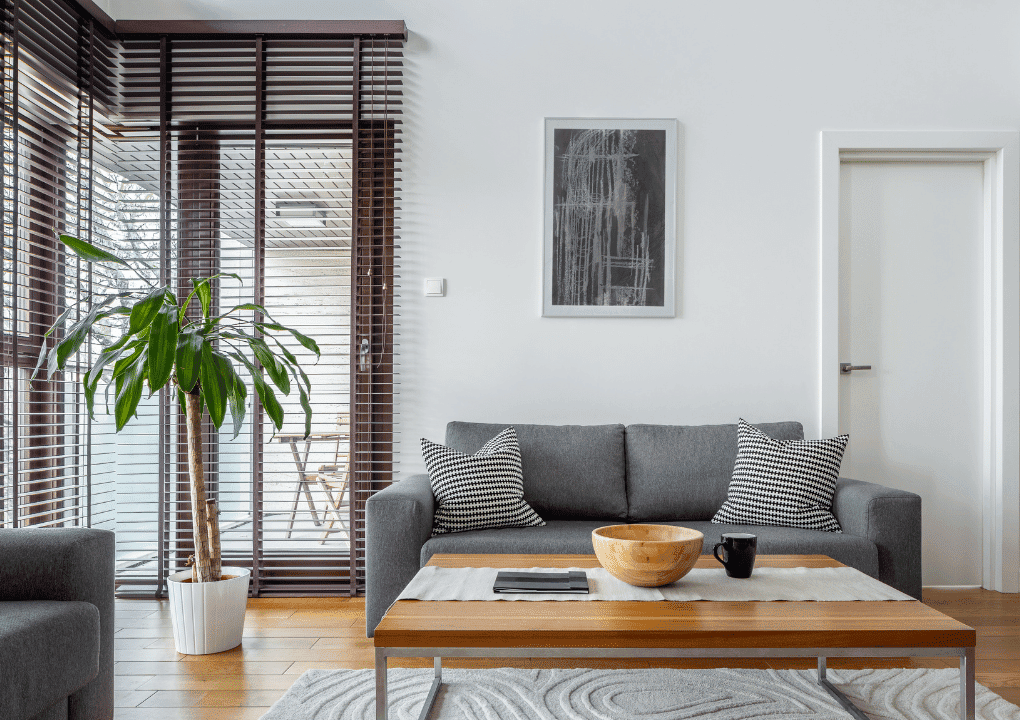
Should blinds be lighter or darker than walls?
When it comes to choosing the color of blinds in relation to the walls, there is no hard and fast rule. The decision largely depends on the overall aesthetic you want to achieve in the room. Here are a few considerations to help you make a decision:
Contrast: If you desire a high contrast look, you can choose blinds that are darker than the walls. For example, if you have light-colored walls, dark blinds can create a bold and striking contrast.
Cohesion: On the other hand, if you prefer a cohesive and harmonious appearance, you can select blinds that are lighter or similar in color to the walls. This can create a sense of continuity and make the room feel more unified.
Focus: If you want the focus to be on the view outside the window rather than the window treatment itself, consider choosing blinds that closely match the wall color. This can help the blinds blend into the background and draw less attention.
Style and Mood: The color of the blinds can also contribute to the overall style and mood of the room. For a clean and modern look, you may opt for blinds that contrast with the walls. On the other hand, if you want a soft and serene ambiance, choosing blinds in a similar or lighter shade than the walls can help achieve that effect.
Ultimately, the decision between lighter or darker blinds than the walls depends on your personal preference and the desired atmosphere you want to create in the room.
It can be helpful to consider factors such as contrast, cohesion, focus, style, and mood to guide your choice. Additionally, you can also consider other elements in the room, such as furniture and accessories, to ensure a cohesive and balanced overall design.

How do you match blinds to a room?
Evaluate the Room: Take a look at the existing color scheme, furniture, and decor in the room. Consider the dominant colors and overall style. This will help you determine whether you want the blinds to blend in or stand out.
Choose a Color Palette: Decide on a color palette for the room. You can either select blinds that complement the existing colors or create contrast for visual interest.
Consider Light Levels: Think about the desired light levels in the room. If you want to maximize natural light, consider lighter-colored blinds that allow light to filter through. For greater privacy and light control, opt for darker or blackout blinds.
Material and Texture: Consider the material and texture of the blinds. If you have a modern or minimalist style, sleek and smooth materials like aluminum or faux wood blinds may be suitable. For a softer or more traditional look, consider fabric shades or wood blinds.
Samples and Swatches: Obtain samples or swatches of the blinds you are considering. Bring them into the room and hold them up against the walls, furniture, and other elements to assess how well they match.
Visualize the Final Look: Imagine how the chosen blinds will look in the room. Picture them against the walls, taking into account factors such as natural light, furniture placement, and overall aesthetics.
Seek Expert Advice: If you’re uncertain about your choices, consider consulting with a professional interior designer or window treatment specialist. They can provide valuable insights and guidance based on their expertise.
Different Types of Shades:
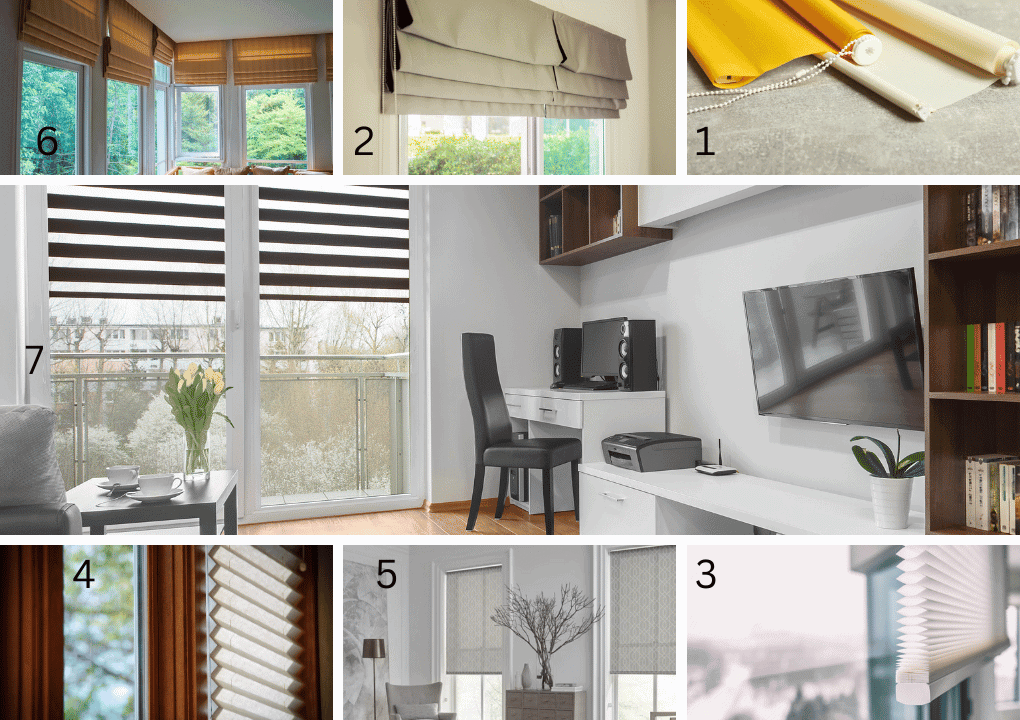
1. Roller Shades:
Roller shades consist of a single piece of fabric that rolls up and down on a roller mechanism. They are simple and versatile, offering various levels of light control and privacy.
2. Roman Shades:
Roman shades are made of fabric that folds into pleats when raised and forms a flat panel when lowered. They provide an elegant and tailored look to windows. Roman shades offer various levels of light filtering or blackout options and can be customized with different fabric choices and patterns.
3. Cellular Shades/Honeycomb Shades:
Cellular shades, also known as honeycomb shades, are constructed with honeycomb-shaped cells that trap air and provide excellent insulation. They come in single, double, or triple cell designs, offering different levels of energy efficiency.
4. Pleated Shades:
Pleated shades are similar to cellular shades in appearance but have a simpler construction. They usually have a single layer of pleated fabric that can be raised or lowered to control light and privacy.
5. Solar Shades:
Solar shades are designed to reduce glare and block harmful UV rays while still allowing some natural light to enter the room. They are made of specialized fabrics that effectively filter sunlight without obstructing the view. I love using solar shades in commonly used in spaces where preserving the outside view is essential, such as offices or rooms with scenic vistas.
6. Bamboo/Woven Wood Shades:
Bamboo or woven wood shades are crafted from natural materials like bamboo, reeds, or grasses. They provide a unique, organic, and rustic look to windows. These shades allow diffused light to enter the room and offer varying degrees of privacy depending on the material and weave.
7. Sheer Shades:
Sheer shades combine the features of both shades and blinds. They consist of horizontal fabric vanes suspended between two layers of sheer fabric. Sheer shades provide a soft and delicate appearance while offering light control and privacy. They can be adjusted to allow diffused light or completely closed for privacy.
These are just a few examples of the many types of shades available in the market. Each type has its unique characteristics, functionalities, and design aesthetics.
What should I consider when buying shades?
When choosing a shade, consider factors such as light control, privacy, energy efficiency, and the desired style for your space.
WANT TO SHOP THESE RUNNERS? CLICK ON AN IMAGE BELOW. THESE ARE AFFILIATE LINKS AND IF USED I MAKE A SMALL COMMISSION AT NO COST TO YOU. THANKS FOR SUPPORTING THE BRANDS THAT SUPPORT THIS BLOG OF MINE!
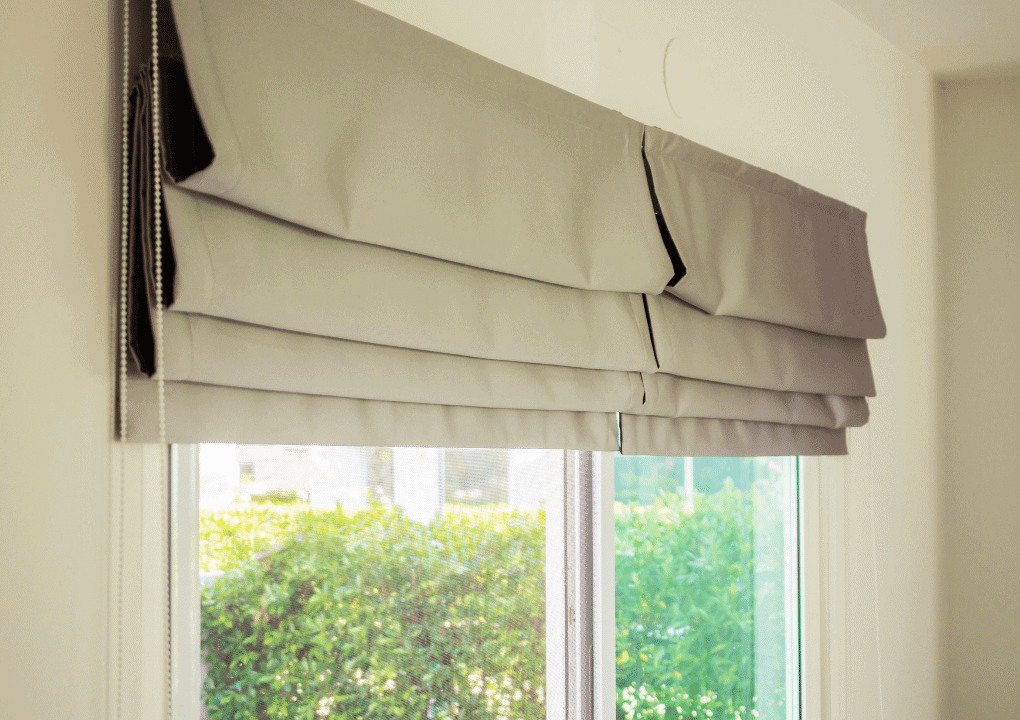
What is the difference between Roman blinds and shades?
Roman blinds and shades are both popular window coverings, but they differ in their design and functionality.
Roman blinds consist of fabric panels that fold into pleats when raised and form a flat panel when lowered. They offer a clean, tailored look to windows and provide varying levels of light control and privacy.
Roman blinds are typically operated with a cord or chain mechanism. On the other hand, shades are made of a single piece of fabric that can be raised or lowered to control light and privacy.
They do not fold into pleats but create a smooth, continuous appearance. Shades come in different types like roller shades, cellular shades, or solar shades, offering various levels of light filtering or blackout options.
You can generally find shades with a cord, chain, or motorized system, depending on which you prefer. While both Roman blinds and shades provide window coverage, Roman blinds offer a more structured and decorative style, while shades provide versatility with a range of options for light control and fabric choices.
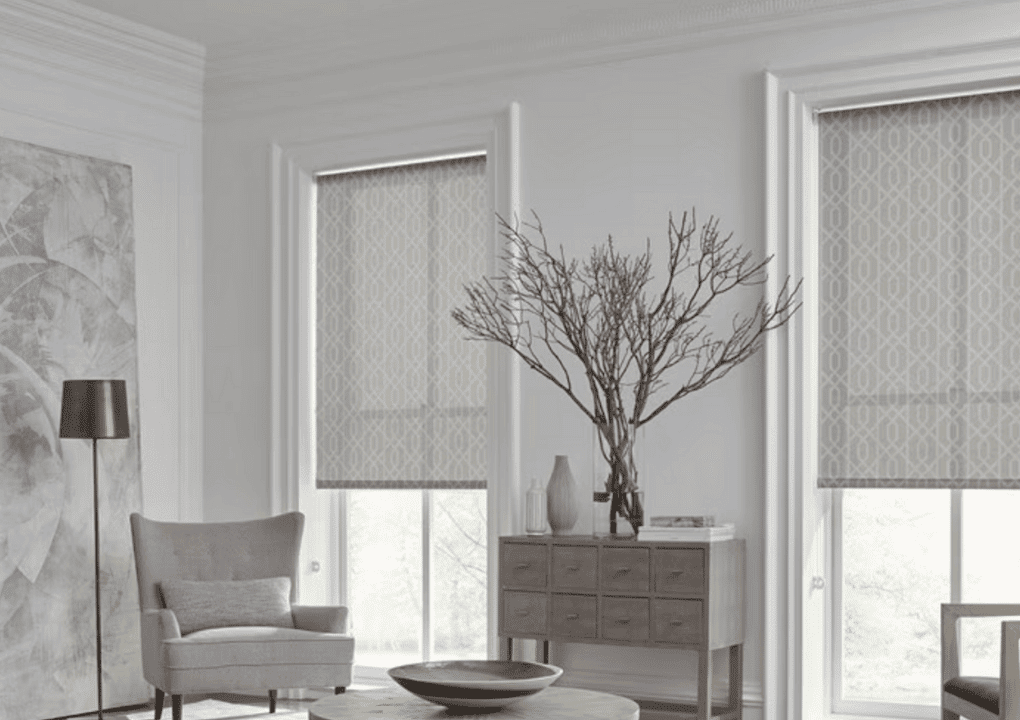
What is the downside to roman shades?
While Roman shades offer an elegant and tailored look to windows, they do have a few potential downsides to consider.
One drawback is that Roman shades can be more challenging to clean compared to other types of window coverings. The fabric folds and pleats can trap dust and require more effort for thorough cleaning.
Additionally, Roman shades are generally not ideal for high-moisture areas such as bathrooms or kitchens, as moisture can affect the fabric and potentially lead to mold or mildew growth.
Another aspect to consider is that Roman shades can be bulkier when fully raised compared to other window coverings, which may affect the amount of visible window space.
Lastly, depending on the fabric chosen, some Roman shades may allow some light gaps between the folds when fully lowered, compromising complete light blocking and privacy.
These considerations are important to keep in mind when deciding on the most suitable window treatment for your specific needs and preferences.
When are shutters best used?
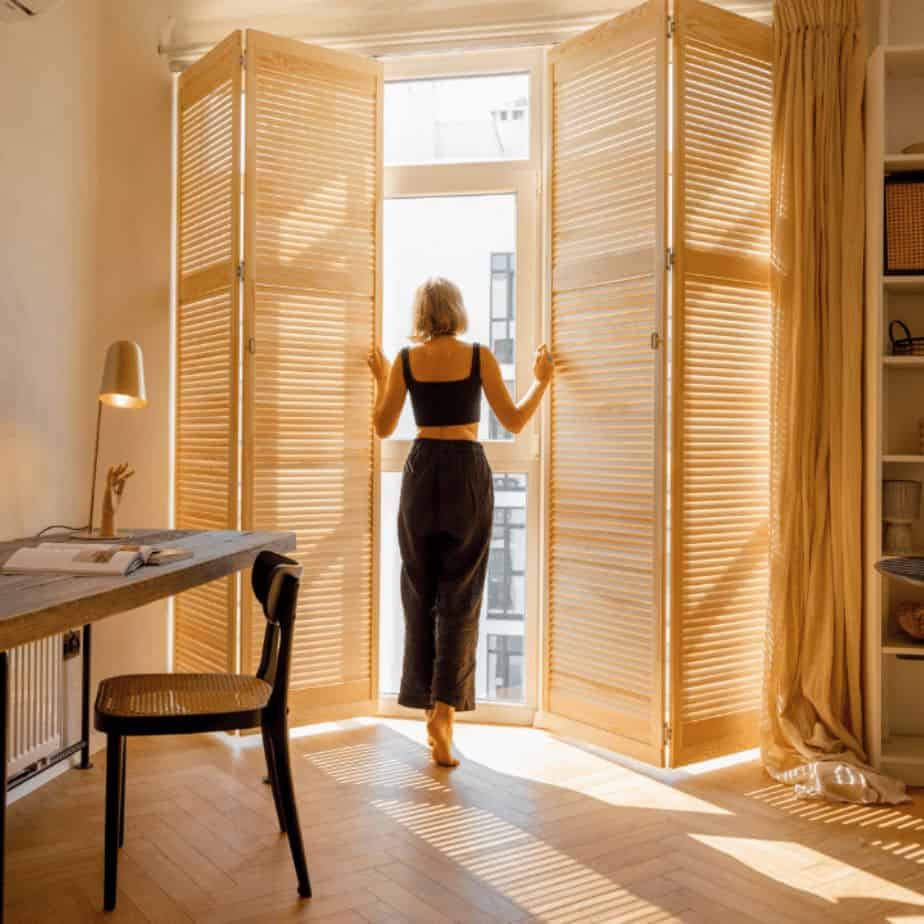
Choosing which shades are best really depends on the following situations:
Timeless Elegance: Shutters offer a classic and timeless look that can enhance the overall aesthetic of any room. They add a touch of sophistication and elegance, making them well-suited for traditional, transitional, and even contemporary decor styles.
Durability and Longevity: Shutters are typically made of solid materials such as wood or vinyl, which ensures their durability and longevity. This is why you generally see them used on the exterior of a home.
Light Control and Privacy: Shutters provide excellent control over both light and privacy. By adjusting the louvers, you can regulate the amount of light entering the room while maintaining privacy. Shutters are a great option for bedrooms, living rooms, and spaces where you desire both natural light and seclusion.
Insulation: Shutters have insulating properties, helping to regulate temperature and reduce energy consumption. They can provide an additional layer of insulation, keeping your home cooler in the summer and warmer in the winter.
Versatility: Shutters are available in various styles, including full-height, café-style, and tier-on-tier, allowing for flexibility in design choices. They can be custom-made to fit different window shapes and sizes, ensuring a tailored and cohesive look throughout your home.
Increased Home Value: Shutters are considered a desirable feature in a home and can increase its resale value. They offer a high-end, luxurious appeal that can attract potential buyers.
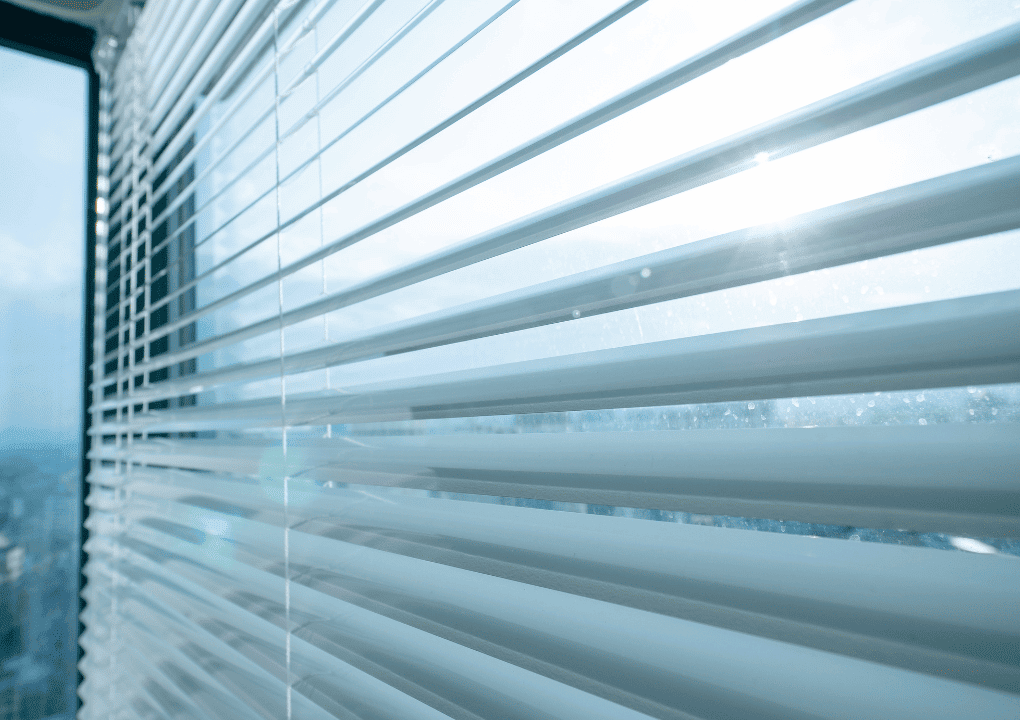
What is the difference between cheap and expensive blinds?
The difference between cheap and expensive blinds lies primarily in the quality of materials, craftsmanship, and additional features.
Cheap blinds tend to be made from lower-grade materials, such as thin or flimsy fabrics, lightweight plastics, or less durable components. They may lack durability and longevity, requiring more frequent replacement.
In contrast, expensive blinds are typically crafted with higher-quality materials like premium fabrics, sturdy metals, or genuine wood. They are designed to withstand daily use and offer better durability, but I find that the new synthetic materials these days are constructed to be quite strong as well.
Expensive blinds often come with additional features such as motorization, cordless operation, or advanced light control options. These features enhance convenience, functionality, and overall user experience.
Additionally, expensive blinds may offer a wider range of customization options in terms of color, texture, and design.
Ultimately, while cheap blinds can provide a budget-friendly option, investing in more expensive blinds often results in superior quality, durability, and enhanced features.
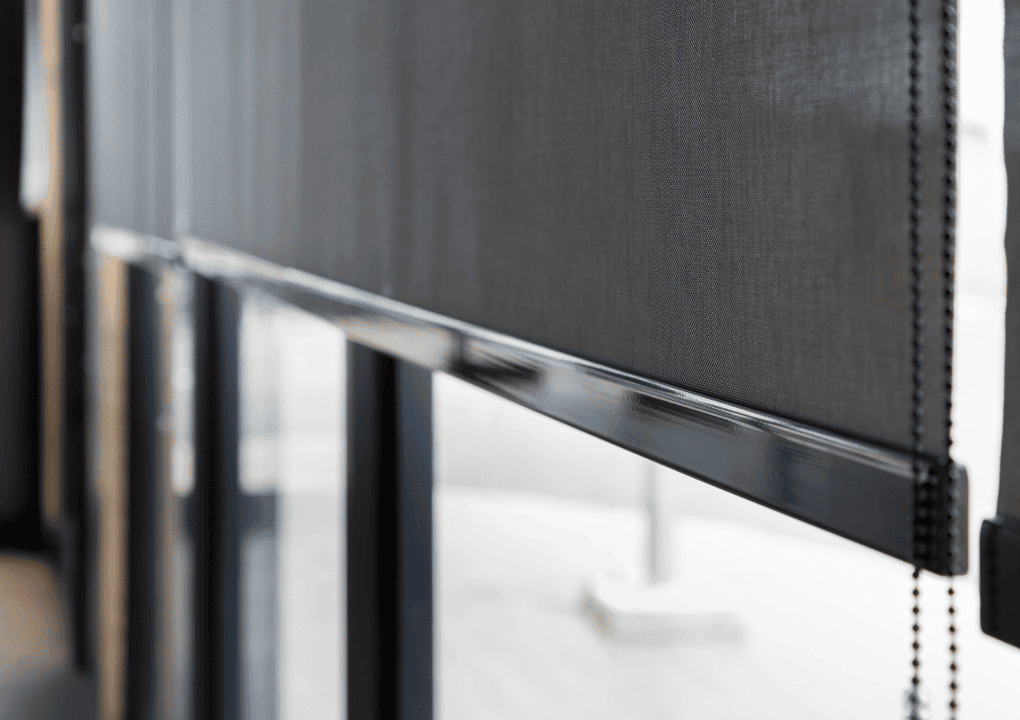
What blinds can see out but not in?
Blinds that allow you to see out but not in are commonly known as “daytime privacy blinds” or “vision blinds.” They are designed to provide privacy during the day while still allowing a view of the outside.
These blinds typically have a sheer or semi-opaque fabric that diffuses incoming light and obscures the view from the outside, but still enables visibility to the outside from the inside.
One popular type of blinds that offer this feature is called “zebra blinds” or “day and night blinds.” They consist of alternating horizontal bands of sheer and opaque fabric that can be aligned to control light and privacy.
By adjusting the position of the bands, you can achieve different levels of privacy and outside visibility.
Another option is “sheer blinds” or “voile blinds,” which are made of a transparent or semi-transparent fabric that allows light to pass through while providing a level of privacy during the day.
These blinds soften the incoming light and offer a subtle view of the outside while preventing a clear view into the room from the outside.
It’s important to note that the level of privacy provided by these blinds can vary depending on factors such as lighting conditions and the distance between the blinds and the outside viewer.
For enhanced privacy, you may consider pairing these blinds with curtains or drapes for added opacity during the evening or nighttime hours.

What is the latest trend in blinds?
Motorized Blinds: The integration of smart technology and home automation has made motorized blinds increasingly popular. These blinds can be controlled remotely through mobile apps or voice assistants, offering convenience, ease of use, and enhanced energy efficiency.
Natural and Organic Materials: There has been a growing trend towards using natural and sustainable materials in blinds, such as bamboo, woven wood, or eco-friendly fabrics. These materials provide a warm, organic look and contribute to a more environmentally conscious approach to window treatments.
Layering and Mixing: Layering different types of window coverings, such as combining blinds with curtains or drapes, has become a popular trend. This approach allows for more versatility in light control, privacy, and aesthetics. Mixing different textures, patterns, and colors can create visual interest and add depth to a space.
Soft and Sheer Fabrics: Blinds with soft and sheer fabrics, such as sheer shades or light-filtering materials, have gained popularity. These types of blinds allow diffused natural light to enter while providing privacy and a soft, elegant appearance. They create a soothing ambiance and work well in contemporary and minimalist designs.
Bold Colors and Patterns: While neutral colors remain timeless, there is an increasing trend towards using bolder colors and patterns in blinds. Vibrant hues, geometric designs, and floral patterns are being embraced to add personality, create focal points, or make a statement within a room.
Which blinds are most popular?

Based on general market trends and popularity, the most commonly purchased type of blinds is the Venetian blinds.
Venetian blinds are known for their versatility, functionality, and timeless design. They feature horizontal slats that can be adjusted to control light and privacy levels, making them a popular choice for various rooms and window sizes.
Venetian blinds are available in different materials, such as aluminum, faux wood, or real wood, offering a wide range of style options to suit different preferences and budgets. Their widespread availability and popularity make Venetian blinds the most frequently purchased type of blinds.
What is the average price for a set of blinds?
The average price for a set of blinds can vary widely depending on several factors, including the type of blinds, the size of the windows, the material used, and any additional features or customization. Here’s a general price range to give you an idea:
Standard Vinyl or Aluminum Blinds: These are typically the most affordable options and can range from around $10 to $50 per window, depending on the size and brand.
Faux Wood Blinds: Faux wood blinds offer a more premium look at a lower cost compared to real wood blinds. The price range for faux wood blinds can vary from approximately $30 to $100 per window.
Real Wood Blinds: Real wood blinds are considered a higher-end option and tend to be more expensive. Prices for real wood blinds can range from $50 to $200 or more per window, depending on the wood species, size, and customization.
Cellular Shades/Honeycomb Shades: Cellular shades provide insulation and energy efficiency. The average price range for cellular shades is typically between $50 and $150 per window, depending on the size and features.
Roller Shades: Roller shades offer a clean and minimalistic look. Prices for roller shades can vary, starting from around $20 and going up to $150 or more per window, depending on the fabric, size, and additional features.
These price ranges are approximate and can vary significantly based on various factors.
Custom sizes, motorization, additional features, and high-end materials can increase the cost. It’s advisable to get quotes from multiple retailers or consult with professionals to get accurate pricing based on your specific requirements.
What is the best choice for window blinds?

The best choice for window blinds depends on factors such as your personal preferences, the specific needs of the space, and the desired style. Consider factors such as light control, privacy, durability, ease of maintenance, and aesthetic appeal when choosing the best blinds for your windows.
What type of blinds are most expensive?
The cost of blinds can vary based on factors such as material, size, brand, and additional features.
Generally, the most expensive types of blinds are those made from high-quality materials like real wood, customized designs, or motorized options.
Here are a few examples of blinds that are typically more expensive:
- Real Wood Blinds: Real wood blinds tend to be more expensive due to the natural beauty and premium quality of the material.
- Motorized Blinds: Blinds with motorization capabilities, allowing for remote control operation or integration with smart home systems, often come with a higher price tag.
- Customized or Specialty Blinds: Blinds that are custom-made to fit specific window sizes or have unique designs, patterns, or finishes are typically more expensive than standard off-the-shelf options.
How to choose the right blinds or shades for each room in your house?
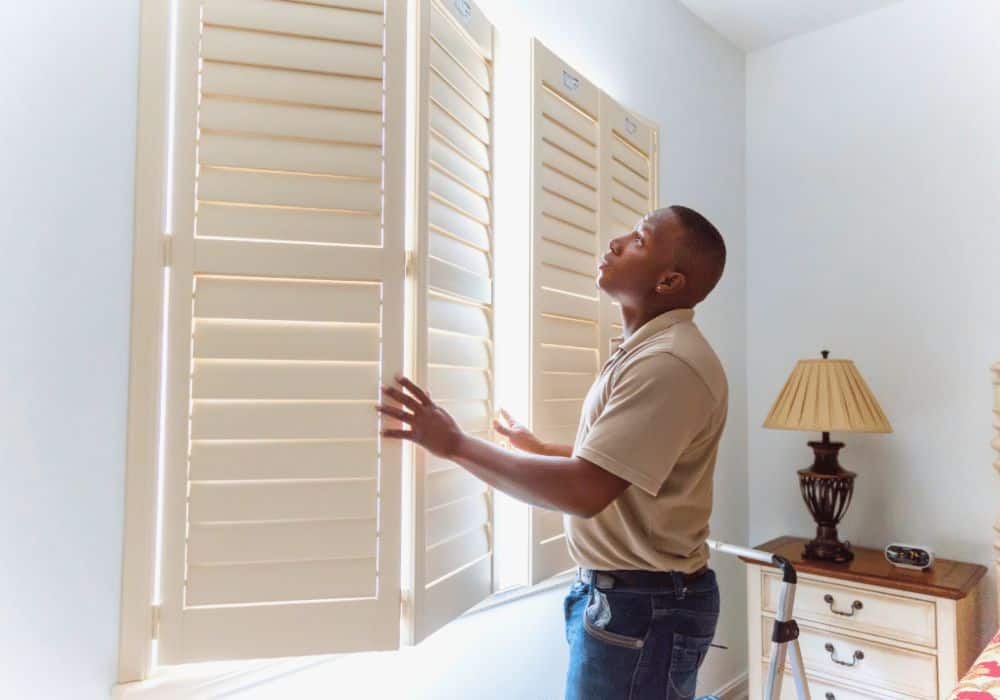
When choosing blinds or shades for each room in your house, here are considerations for various factors:
Light Control:
Evaluate how much light control you desire in each room. Rooms like bedrooms or home theaters may benefit from blackout shades or blinds that can block out light effectively. Light-filtering options, such as sheer shades or blinds with adjustable slats, can be suitable for living rooms or kitchens where you want some natural light while reducing glare.
Privacy:
Determine the level of privacy needed in each room. Bedrooms and bathrooms typically require higher privacy, so consider blinds or shades that offer good coverage and opacity. Top-down/bottom-up shades can be a great option as they allow you to control privacy while still allowing natural light in.
Cleaning:
Consider the ease of cleaning and maintenance. Blinds with individual slats can accumulate dust and may require regular dusting or wiping. Shades made of fabric can be spot cleaned or gently vacuumed. Choose blinds or shades that align with your preference for cleaning and maintenance efforts.
Insulation:
If energy efficiency is a concern, look for blinds or shades that offer good insulation. Cellular shades, also known as honeycomb shades, have a cellular construction that traps air and can help regulate temperature and save on energy costs.
Safety:
If you have children or pets at home, cordless or motorized blinds can be a safer choice. Cordless options eliminate the risk of entanglement, while motorized blinds allow for easy operation without the need for cords or chains.
Style:
Consider the style and aesthetic of each room. Blinds and shades come in various materials, colors, patterns, and designs. Choose options that complement the existing decor and contribute to the desired ambiance in each space.
Cost:
Set a budget for each room and explore blinds or shades within that range. Keep in mind that the cost can vary depending on factors like material, size, additional features, and brand. Consider the long-term value and durability of the window coverings to make an informed decision.
Do curtains and blinds work together?
Curtains and blinds can work together to provide both functional and aesthetic benefits. Combining curtains and blinds allows for enhanced light control, privacy, and style.
For example, you can use blinds for precise light adjustment and privacy during the day, while adding curtains for a softer, decorative touch and additional insulation during colder months.
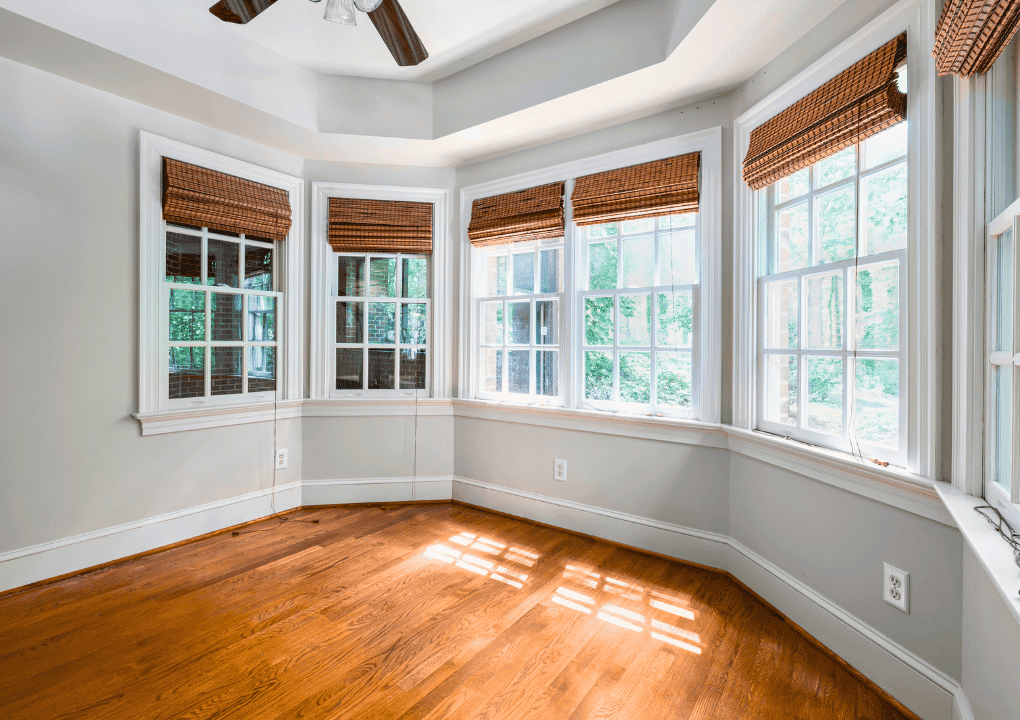
Can I use blinds instead of curtains?
you can certainly use blinds instead of curtains. Blinds alone can provide effective light control, privacy, and a clean, minimalist look. They are a popular choice for many homeowners who prefer a sleek and practical window covering option without the need for curtains.

Can you have windows without curtains?
Windows can absolutely be left without curtains. The decision to use curtains or not depends on personal preference, the desired level of privacy, light control, and the overall style you want to achieve in a space.
Some individuals prefer the simplicity of bare windows, while others may opt for blinds, shades, or other window coverings that meet their functional and aesthetic needs.
How do you cover window blinds with curtains?
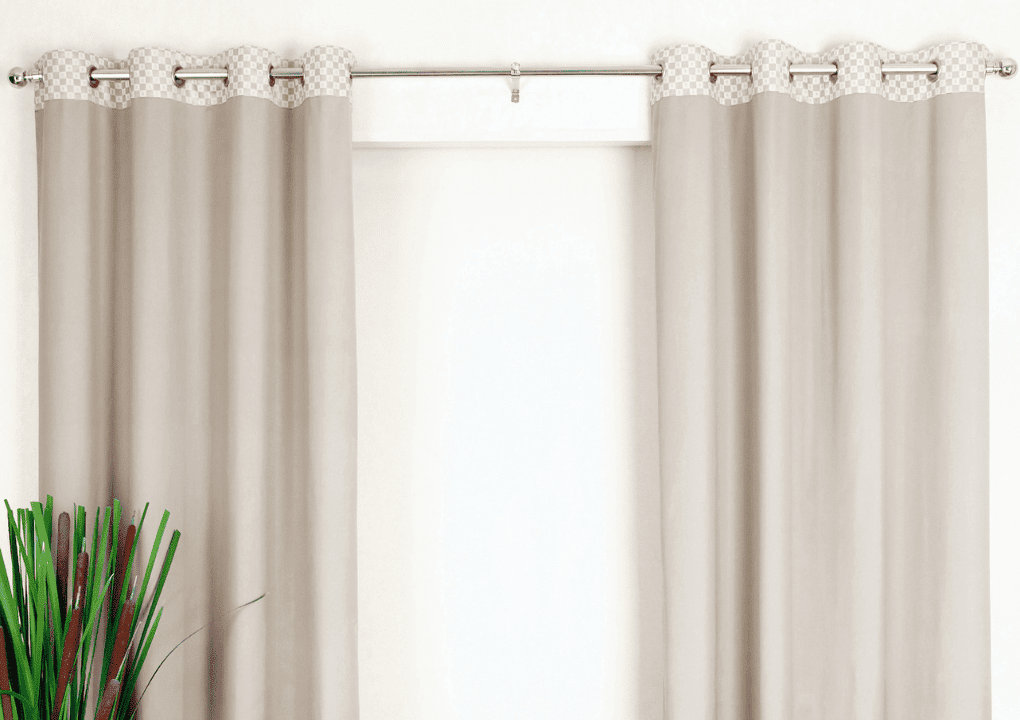
To cover window blinds with curtains, you can follow these steps:
- Install the blinds: Start by installing the blinds according to the manufacturer’s instructions. Ensure that the blinds are properly mounted and operational.
- Measure the curtain length: Measure the desired length for the curtains, keeping in mind factors like floor clearance and aesthetic preferences.
- Install curtain hardware: Install curtain rods or tracks above the window, ensuring they are securely attached to the wall. Follow the specific instructions for the chosen curtain hardware. For lower ceilings, attach the hardware as high up as you can above the window. This will give the illusion that your ceilings are higher than they are.
- Hang the curtains: Slide the curtains onto the curtain rods or attach them to the curtain tracks. Adjust the curtains to the desired position and ensure they hang evenly on both sides.
- Coordinate the look: Adjust the blinds and curtains to achieve the desired balance of light control and privacy. Coordinate the colors, patterns, and textures of the blinds and curtains to complement each other and the overall room decor.
What are the Do’s and Don’ts of Pairing Curtains and Blinds
Do’s of pairing curtains and blinds:
Don’ts of pairing curtains and blinds:
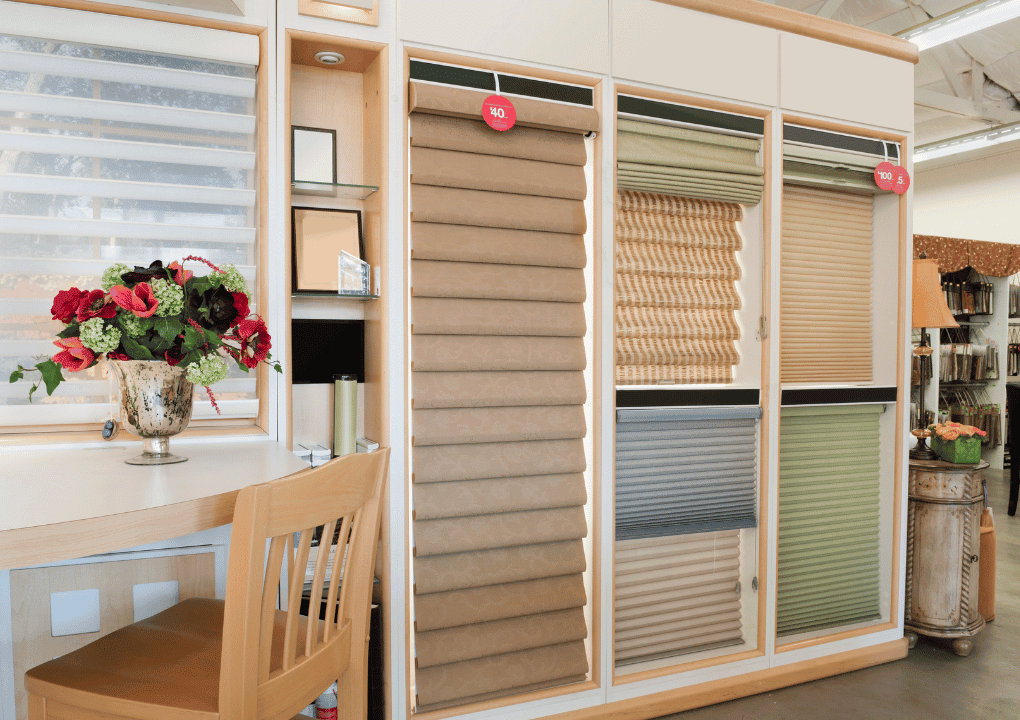
In closing
Ultimately, the pairing of curtains and blinds should be based on personal preference, functionality, and the desired aesthetic outcome for the room.
Blinds and shades offer versatile window covering options for your home, each with its own benefits and considerations. Blinds, such as Venetian or vertical blinds, are excellent choices when you desire precise light control, privacy, and a sleek, modern look.
They work well in areas like living rooms, offices, or kitchens where functionality is key. On the other hand, shades, like roller or cellular shades, provide a softer and more elegant appearance while offering various light-filtering options and insulation benefits.
They are ideal for bedrooms, nurseries, or spaces where a cozy ambiance is desired. Ultimately, the decision to use blinds or shades in your home depends on your personal preferences, the specific needs of each room, and the desired style and functionality you wish to achieve.
Thanks for reading!
Be sure to pin for later!
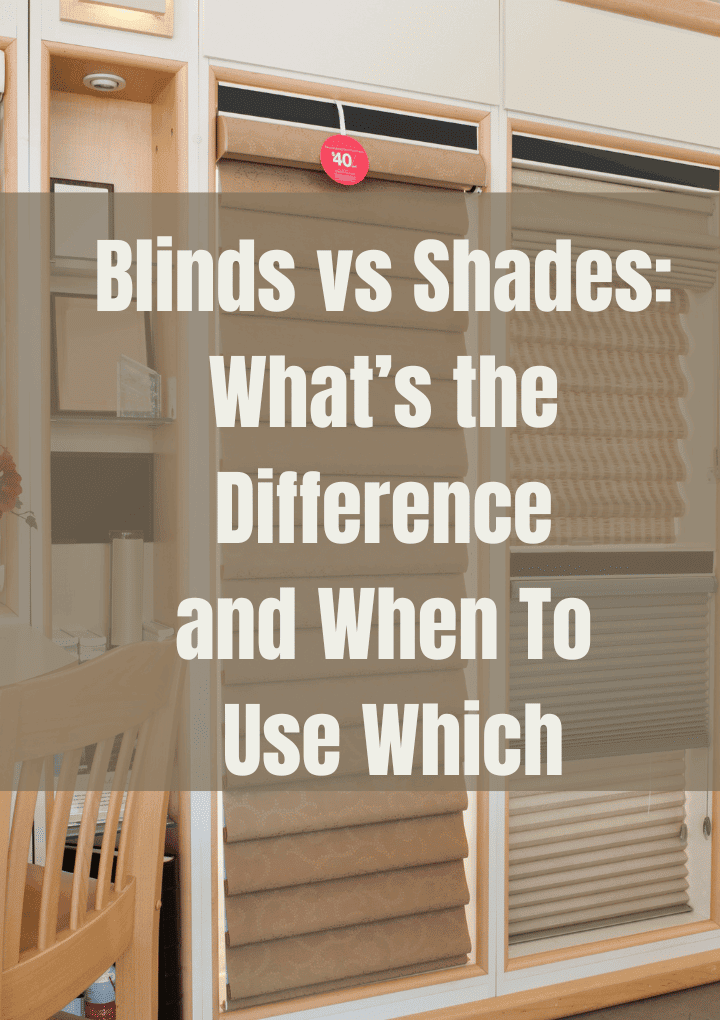
Want to read more about updating your home on a budget? Read on below!
